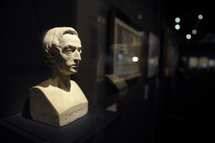
"Frederic Chopin, the Blue Note" opened this week in the green-shuttered Musee de la Vie Romantique at the foot of Montmartre to mark the anniversary of Chopin's birth, variously given as February 22 and March 1, 1810.
It revisits his life in his father's home country through some 90 paintings, drawings and other works by contemporary greats including Delacroix, Corot, Courbet and Ingres.
The 1843 Pleyel piano Chopin played in France is also on display, along with an 1839 sketch by the musician entitled "Man's Head", showing his talent as a portraitist.
The show captures the heady days when Chopin, fellow composers Liszt, Rossini, Berlioz and other luminaries of the Romantic movement including Chopin's companion, feminist and writer George Sand, and friend Eugene Delacroix, gathered for Friday night salons in what was the home of Dutch-born painter Ary Scheffer on Rue Chaptal.
The exhibition's name comes from Sand and Delacroix, who said they heard "colour" when Chopin played his music. It opens with an 1838 Chopin portrait by Delacroix on loan from the Louvre.
Though browns dominate, "the blue note resonates," Sand once wrote, saying the painting had the same "azure of the transparent night" as the preludes, nocturnes and polonaises Chopin wrote for piano.
"When the idea was proposed two years ago to organise an exhibition in honor of Chopin's bicentenary, we decided to explore the relationship between his music and painting, stressing the 'blue note' that George Sand and Delacroix said they heard in his musical works," said curator Jerome Godeau.
"This 'blue note' is like a reverberation of Chopin's inner world, a poetic world, torn by exile and suffering for his motherland," said Godeau, describing the composer as "a dandy, delicate and torn, one whom, as Sand said, the shadow of a rose petal could hurt."
While the musical world has dedicated the year 2010 to Chopin's music, notably in Warsaw near where he was born, the two Paris shows focus on his time in France.
Chopin left Poland in 1830 at age 20, just before a Polish revolt that was suppressed by imperial Russia. He arrived in France a year later and died in Paris 1849 at 39, apparently from tuberculosis. His body is buried in the Pere Lachaise cemetery though his heart, at his request, was sent back home.
One painting, "Le Boulevard Poissonniere" by Isidore Dagnan shows his first Paris residence, while another Delacroix work, "George Sand's Garden at Nohant" on loan from the Metropolitan Museum of Art, depicts the bucolic estate where the at times turbulent lovers spent summers.
The exhibition runs though July 11 (ww.vie-romantique.paris.fr).
Paris' Cite de la Musique cultural center will also host a multi-media exhibition entitled "Chopin in Paris, the Composer's Workshop" from March 9 to June 6, exploring the evolution of his work and his preference for the intimacy of salons and small venues rather than huge public concerts (www.cite-musique.fr).
-------------------------------------------------------------------------------
It revisits his life in his father's home country through some 90 paintings, drawings and other works by contemporary greats including Delacroix, Corot, Courbet and Ingres.
The 1843 Pleyel piano Chopin played in France is also on display, along with an 1839 sketch by the musician entitled "Man's Head", showing his talent as a portraitist.
The show captures the heady days when Chopin, fellow composers Liszt, Rossini, Berlioz and other luminaries of the Romantic movement including Chopin's companion, feminist and writer George Sand, and friend Eugene Delacroix, gathered for Friday night salons in what was the home of Dutch-born painter Ary Scheffer on Rue Chaptal.
The exhibition's name comes from Sand and Delacroix, who said they heard "colour" when Chopin played his music. It opens with an 1838 Chopin portrait by Delacroix on loan from the Louvre.
Though browns dominate, "the blue note resonates," Sand once wrote, saying the painting had the same "azure of the transparent night" as the preludes, nocturnes and polonaises Chopin wrote for piano.
"When the idea was proposed two years ago to organise an exhibition in honor of Chopin's bicentenary, we decided to explore the relationship between his music and painting, stressing the 'blue note' that George Sand and Delacroix said they heard in his musical works," said curator Jerome Godeau.
"This 'blue note' is like a reverberation of Chopin's inner world, a poetic world, torn by exile and suffering for his motherland," said Godeau, describing the composer as "a dandy, delicate and torn, one whom, as Sand said, the shadow of a rose petal could hurt."
While the musical world has dedicated the year 2010 to Chopin's music, notably in Warsaw near where he was born, the two Paris shows focus on his time in France.
Chopin left Poland in 1830 at age 20, just before a Polish revolt that was suppressed by imperial Russia. He arrived in France a year later and died in Paris 1849 at 39, apparently from tuberculosis. His body is buried in the Pere Lachaise cemetery though his heart, at his request, was sent back home.
One painting, "Le Boulevard Poissonniere" by Isidore Dagnan shows his first Paris residence, while another Delacroix work, "George Sand's Garden at Nohant" on loan from the Metropolitan Museum of Art, depicts the bucolic estate where the at times turbulent lovers spent summers.
The exhibition runs though July 11 (ww.vie-romantique.paris.fr).
Paris' Cite de la Musique cultural center will also host a multi-media exhibition entitled "Chopin in Paris, the Composer's Workshop" from March 9 to June 6, exploring the evolution of his work and his preference for the intimacy of salons and small venues rather than huge public concerts (www.cite-musique.fr).
-------------------------------------------------------------------------------









 Home
Home Politics
Politics









